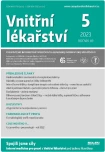Atypical form of Goodpasture’s disease
Authors:
Michaela Habánová 1,4; Petra Divácká 2,4; Jitka Řehořová 2,4; Iva Svobodová 3,4
Authors‘ workplace:
Interní hematologická a onkologická klinika, Fakultní nemocnice Brno
1; Interní gastroenterologická klinika, Fakultní nemocnice Brno
2; I. ústav patologie, Fakultní nemocnice u sv. Anny, Brno
3; Lékařská fakulta, Masarykova univerzita, Brno
4
Published in:
Vnitř Lék 2023; 69(5): 316-321
Category:
Case Reports
doi:
https://doi.org/10.36290/vnl.2023.062
Overview
Goodpasture’s disease and anti-glomerular basement membrane nephritis (anti-GBM nephritis) are rare autoimmune small vessel vasculitis predominantly affecting young men. Goodpasture’s disease plays an important part in differential diagnosis of pulmonary – renal syndrome. The evidence of circulating autoantibodies, a typical histological appearance of the kidney biopsy with finding of the crescent glomerulonephritis and clinical presentation of nephritic syndrome play an important role in diagnosis. Our case report describes a case of a young male with anti-GBM nephritis that presents as rapidly progressive glomerulonephritis (RPGN) with progression to dialysis-dependent renal failure. The atypical sign of the case was development of nephrotic syndrome with volume-dependent hypertension. The case was complicated by heparin-induced thrombocytopenia. During combined immunosuppressive therapy with plasmapheresis, the condition of the patient has stabilized. However, renal function did not recover. This previously fatal disease has nowadays a very good survival rate because of immunosuppresion therapy, plasmapheresis and hemodialysis.
Keywords:
plasmapheresis – immunosuppression – anti-GBM nephritis – Goodpasture’s disease – nephritic syndrome – rapidly progressive glomerulonephritis
Sources
- Cui Z, Turner AN, Zhao MH. Antiglomerular basement membrane disease: Overview, clinical features and diagnosis, treatment and outcomes. In: Turner AN, et al, (eds). Oxford Textbook of Nephrology. 4th ed. Oxford: Oxford University Press;2015:598-608.
- Goodpasture EW, The significance of certain pulmonary lesions in relation to the etiology of influenza. Am J Med Sci. 1919;158(6);863-870. Available from: DOI: <https://doi. org/10.1097/00000441-191911000-00012>.
- Feehally J, Floege J, Tonelli M, et al. Comprehensive Clinical Nephrology. In: Floege J, (eds) et al. 6th ed. Elsevier Inc: Edinburgh 2019: 281–289. ISBN 978-0-323-47909-7.
- Kidney Disease: Improving Global Outcomes (KDIGO) Glomerular Diseases Work Group (2021). KDIGO 2021 Clinical Practice Guideline for the Management of Glomerular Diseases. Kidney international, 100(4S), S1-S276. Available from: DOI: <https://doi.org/10.1016/j.kint.2021.05.021>.
- Levy JB, Turner AN, Rees AJ, et al. Long-term outcome of anti–glomerular basement membrane antibody disease treated with plasma exchange and immunosuppression. Ann Intern Med. 2001;134:1033-1042.
- McAdoo SP, Pusey CD. Anti-Glomerular Basement Membrane Disease. Clin J Am Soc Nephrol. 2017;12(7): 1162-1172.
- McAdoo SP, Tanna A, Hrušková Z, et al. Patients double-seropositive for ANCA and anti-GBM antibodies have varied renal survival, frequency of relapse, and outcomes compared to single-seropositive patients. Kidney Int. 2017; 9 (3):693-702. Available from: DOI: <http://doi: 10.1016/j.kint.2017. 03. 014>.
- Alchi B, Griffiths M, Sivalingam V, et al. Predictors of renal and patient outcomes in anti-GBM disease: clinicopathologic analysis of a two-centre cohort, Nephrology Dialysis Transplantation. 2015;30(5):814-821. Available from: doi: <http://doi: 10.1093/ndt/gfu399>.
- Sethi S, Fervenza F. Standardized classification and reporting of glomerulonephritis, Nephrology Dialysis Transplantation,2019, 34:193-199, Available from: DOI: <http://doi: 10.1093/ ndt/gfy220>.
- Chudáček Z. HRCT plic – technika vyšetření, CT anatomie, základní typy patologických nálezů. Med. Praxi. 2010;7 (6 a 7):299-302.
- Derksen RH, Schuurman HJ, Meyling FH, et al. The efficacy of plasma exchange in the removal of plasma components. J Lab Clin Med. 1984;104 (3):346-5.
- Lockwood CM, Boulton-Jones JM, Lowenthal RM, et al. Recovery from Goodpasture’s syndrome after immunosuppressive treatment and plasmapheresis. Br Med J. 1975;2(5965):252-4.
- Soveri I, Molne J, Uhlin F, et al. The IgGdegrading enzyme of Streptococcus pyogenes causes rapid clearance of antiglomerular basement membrane antibodies in patients with refractory antiglomerular basement membrane disease. Kidney Int. 2019;96:1234-1238.
- Paříková A, IgGdegradující enzym Streptococcus pyogenes (IdeS) vede k rychlému odstranění protilátek proti glomerulární bazální membráně (antiGBM) u pacientů s refrakterní antiGBM glomerulonefritidou. Postgraduální nefrologie. 2019;4:19-21. Available from: <https://www.postgradualninefrologie.cz/cislo-xvii-4/igg-degradujici-enzym-streptococcus-pyogenes-ides-vede-k-rychlemu-odstraneni-pro/>.
- Stone JH, Merkel PA, Spiera R, et al. Rituximab versus cyclophosphamide for ANCA-associated vasculitis. N Engl J Med. 2010;363 (3):221-32. Available from: DOI: <http://doi: 10.1056/NEJMoa0909905>.
- Touzot M, Poisson J, Faguer S, et al. Rituximab in anti-GBM disease: A retrospective study of 8 patients. J Autoimmun. 2015;60:74-79. d Available from: DOI: <http://doi: 10.1016/j. jaut.2015. 04. 003>.
Labels
Diabetology Endocrinology Internal medicineArticle was published in
Internal Medicine

2023 Issue 5
Most read in this issue
- Acute kidney injury in patients with cirrhosis – practical summary
- Dyslipidemia – the known unknown
- News in respiratory medicine
- Cardiovascular disease and kidney transplantation
